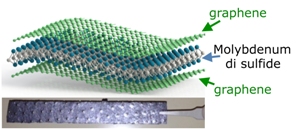Jan 30 2014
A Kansas State University engineer has made a breakthrough in rechargeable battery applications.
 A Kansas State University engineer has made a breakthrough in rechargeable battery applications. The bottom image shows a self-standing molybdenum disulfide/graphene composite paper electrode and the top image highlights its layered structure
A Kansas State University engineer has made a breakthrough in rechargeable battery applications. The bottom image shows a self-standing molybdenum disulfide/graphene composite paper electrode and the top image highlights its layered structure
Gurpreet Singh, assistant professor of mechanical and nuclear engineering, and his student researchers are the first to demonstrate that a composite paper -- made of interleaved molybdenum disulfide and graphene nanosheets -- can be both an active material to efficiently store sodium atoms and a flexible current collector. The newly developed composite paper can be used as a negative electrode in sodium-ion batteries.
"Most negative electrodes for sodium-ion batteries use materials that undergo an 'alloying' reaction with sodium," Singh said. "These materials can swell as much as 400 to 500 percent as the battery is charged and discharged, which may result in mechanical damage and loss of electrical contact with the current collector."
"Molybdenum disulfide, the major constituent of the paper electrode, offers a new kind of chemistry with sodium ions, which is a combination of intercalation and a conversion-type reaction," Singh said. "The paper electrode offers stable charge capacity of 230 mAh.g-1, with respect to total electrode weight. Further, the interleaved and porous structure of the paper electrode offers smooth channels for sodium to diffuse in and out as the cell is charged and discharged quickly. This design also eliminates the polymeric binders and copper current collector foil used in a traditional battery electrode.”
The research appears in the latest issue of the journal ACS-NANO in the article "MoS2/graphene composite paper for sodium-ion battery electrodes."
For the last two years the researchers have been developing new methods for quick and cost-effective synthesis of atomically thin two-dimensional materials — graphene, molybdenum and tungsten disulfide — in gram quantities, particularly for rechargeable battery applications.
For the latest research, the engineers created a large-area composite paper that consisted of acid-treated layered molybdenum disulfide and chemically modified graphene in an interleaved structured. The research marks the first time that such a flexible paper electrode was used in a sodium-ion battery as an anode that operates at room temperature. Most commercial sodium-sulfur batteries operate close to 300 degrees Celsius, Singh said.
Singh said the research is important for two reasons:
- Synthesis of large quantities of single or few-layer-thick 2-D materials is crucial to understanding the true commercial potential of materials such as transition metal dichalcogenides, or TMD, and graphene.
- Fundamental understanding of how sodium is stored in a layered material through mechanisms other than the conventional intercalation and alloying reaction. In addition, using graphene as the flexible support and current collector is crucial for eliminating the copper foil and making lighter and bendable rechargeable batteries. In contrast to lithium, sodium supplies are essentially unlimited and the batteries are expected to be a lot cheaper.
"From the synthesis point of view, we have shown that certain transition metal dichalcogenides can be exfoliated in strong acids," Singh said. "This method should allow synthesis of gram quantities of few-layer-thick molybdenum disulfide sheets, which is very crucial for applications such as flexible batteries, supercapacitors, and polymer composites. For such applications, TMD flakes that are a few atoms thick are sufficient. Very high-quality single-layer flakes are not a necessity."
The researchers are working to commercialize the technology, with assistance from the university's Institute of Commercialization. They also are exploring lithium and sodium storage in other nanomaterials.
Other Kansas State University researchers involved in the project include Lamuel David, lead author on the paper and a doctoral student in mechanical engineering, India, and Romil Bhandavat, recent doctoral graduate.
Read more at http://www.k-state.edu/today/announcement.php?id=12064&category=publications_and_presentations&referredBy=email